Dynamic Response of Nanoscale He Bubbles in Single Crystal Al during Release from a High-Pressure State
Abstract
1. Introduction
2. Simulation Details
3. Results and Discussion
3.1. Thermodynamic Relations on Release
3.2. Growth of He Bubbles
3.3. Spall Damage and Void Evolution
3.4. Microjet and Bubble Bursting
4. Conclusions
Author Contributions
Funding
Data Availability Statement
Conflicts of Interest
References
- Rajainmäki, H.; Linderoth, S.; Hansen, H.E.; Nieminen, R.M.; Bentzon, M.D. Nucleation and growth of helium bubbles in aluminum between 20 and 900 K. Phys. Rev. B 1988, 38, 1087–1904. [Google Scholar] [CrossRef] [PubMed]
- Li, Q.; Parish, C.M.; Powers, K.A.; Miller, M.K. Helium solubility and bubble formation in a nanostructured ferritic alloy. J. Nucl. Mater. 2014, 445, 165–174. [Google Scholar] [CrossRef]
- Wang, Z.J.; Allen, F.; Shan, Z.W.; Hosemann, P. Mechanical behavior of copper containing a gas-bubble superlattice. Acta Mater. 2016, 121, 78–84. [Google Scholar] [CrossRef]
- Neogi, A.; Askari, H.; Abdolrahim, N. Atomistic simulations of the strengthening effect of high-density bubble formation in helium irradiated single crystalline copper. Materials 2018, 1, 139–149. [Google Scholar] [CrossRef]
- Agarwal, S.; Bhattacharya, A.; Trocellier, P.; Zinkle, S.J. Helium induced microstructure damage, nano-scale grain formation and helium retention behaviour of ZrC. Acta Mater. 2019, 163, 14–27. [Google Scholar] [CrossRef]
- Trinkaus, H. Energetics and formation kinetics of helium bubbles in metals. Radiat. Eff. 1983, 78, 189–211. [Google Scholar] [CrossRef]
- Bonilla, L.L.; Carpio, A.; Neu, J.C.; Wolfer, W.G. Kinetics of helium bubble formation in nuclear materials. Physica D 2006, 222, 131–140. [Google Scholar] [CrossRef]
- Robinson, M.; Kenny, S.D.; Smith, R.; Storr, M.T. He migration and bubble formation in Ga stabilised δ-Pu. J. Nucl. Mater. 2014, 444, 493–500. [Google Scholar] [CrossRef]
- Singh, A.; Maji, S.; Nambissan, P.M.G. Helium-dislocation interaction in aluminum. J. Phys. Condens. Matter 2001, 13, 177–187. [Google Scholar] [CrossRef]
- Yang, L.; Zu, X.T.; Gao, F.; Peng, S.M.; Heinisch, H.L.; Long, X.G.; Kurtz, R.J. Dynamic interactions of helium-vacancy clusters with edge dislocations in α-Fe. Physica B 2010, 405, 1754–1758. [Google Scholar] [CrossRef]
- Abe, Y.; Tsuru, T.; Shi, S.; Oono, N.; Ukai, S. Effect of the dilation caused by helium bubbles on edge dislocation motion in α-iron: Molecular dynamics simulation. J. Nucl. Sci. Technol. 2016, 53, 1528–1534. [Google Scholar] [CrossRef]
- Schäublin, R.; Chiu, Y.L. Effect of helium on irradiation-induced hardening of iron: A simulation point of view. J. Nucl. Mater. 2007, 362, 152–160. [Google Scholar] [CrossRef]
- Li, N.; Mara, N.A.; Wang, Y.Q.; Nastasi, M.; Misra, A. Compressive flow behavior of Cu thin films and Cu/Nb multilayers containing nanometer-scale helium bubbles. Scr. Mater. 2011, 64, 974–977. [Google Scholar] [CrossRef]
- Landau, P.; Guo, Q.; Hattar, K.; Greer, J.R. The effect of He implantation on the tensile properties and microstructure of Cu/Fe nano-bicrystals. Funct. Mater. 2013, 23, 1281–1288. [Google Scholar] [CrossRef]
- Landau, P.; Guo, Q.; Hosemann, P.; Wang, Y.; Greer, J.R. Deformation of as-fabricated and helium implanted 100 nm-diameter iron nano-pillars. Mater. Sci. Eng. A 2014, 612, 316–325. [Google Scholar] [CrossRef]
- Glam, B.; Eliezer, S.; Moreno, D.; Perelmutter, L.; Sudai, M.; Eliezer, D. Dynamic fracture and spall in aluminum with helium bubbles. Int. J. Fract. 2010, 163, 217–224. [Google Scholar] [CrossRef]
- Glam, B.; Strauss, M.; Eliezer, S.; Moreno, D. Shock compression and spall formation in aluminum containing helium bubbles at room temperature and near the melting temperature: Experiments and simulations. Int. J. Impact Eng. 2014, 65, 1–12. [Google Scholar] [CrossRef]
- Glam, B.; Strauss, M.; Eliezer, S.; Moreno, D. The preheating effect on the dynamic strength of aluminium containing helium bubbles. J. Phys. Conf. Ser. 2014, 500, 182012. [Google Scholar] [CrossRef]
- Xiao, D.W.; He, L.F.; Zhou, P.; Zou, D.L.; Shu, H. Spall in aluminium with helium bubbles under laser shock loading. Chin. Phys. Lett. 2017, 34, 056201. [Google Scholar] [CrossRef]
- Kubota, A.; Reisman, D.B.; Wolfer, W.G. Dynamic strength of metals in shock deformation. Appl. Phys. Lett. 2006, 88, 241924. [Google Scholar] [CrossRef]
- Shao, J.L.; Wang, P.; He, A.M. Compression-induced stacking fault tetrahedra around He bubbles in Al. J. Appl. Phys. 2014, 116, 163516. [Google Scholar] [CrossRef]
- Wu, W.D.; Shao, J.L. Atomistic study on the dynamic response of the void or helium bubble in aluminum under compression and tension. J. Appl. Phys. 2020, 127, 154902. [Google Scholar] [CrossRef]
- Li, B.; Wang, L.; E, J.C.; Ma, H.H.; Luo, S.N. Shock response of He bubbles in single crystal Cu. J. Appl. Phys. 2014, 116, 213506. [Google Scholar] [CrossRef]
- Flanagan, R.M.; Hahn, E.N.; Germann, T.C.; Meyers, M.A.; Fensin, S.J. Moleculardynamics simulations of ejecta formation in helium-implanted copper. Scr. Mater. 2020, 178, 114–118. [Google Scholar] [CrossRef]
- Wang, X.X.; He, A.M.; Yang, Y.; Wang, P.; Wang, J.G. Shock responses of nanoporous copper with helium doping by molecular dynamics simulations. Comput. Mater. Sci. 2021, 188, 110190. [Google Scholar] [CrossRef]
- Shao, J.L.; Wang, P.; He, A.M.; Duan, S.Q.; Qin, C.S. Influence of voids or He bubbles on the spall damage in single crystal Al. Model. Simul. Mater. Sci. Eng. 2014, 22, 025012. [Google Scholar] [CrossRef]
- Zhou, T.T.; He, A.M.; Wang, P.; Shao, J.L. Spall damage in single crystal Al with helium bubbles under decaying shock loading via molecular dynamics study. Comput. Mater. Sci. 2019, 162, 255–267. [Google Scholar] [CrossRef]
- Zhou, T.T.; He, A.M.; Wang, P. Dynamic evolution of He bubble and its effects on void nucleation-growth and thermomechanical properties in the spallation of aluminum. J. Nucl. Mater. 2020, 542, 152496. [Google Scholar] [CrossRef]
- Shao, J.L.; Wu, W.D. Shock-induced collapse and migration of nanoscale He bubble in single crystal Al. Scr. Mater. 2023, 222, 115033. [Google Scholar] [CrossRef]
- Zhakhovskii, V.V.; Inogamov, N.A.; Petrov, Y.V.; Ashitkov, S.I.; Nishihara, K. Molecular dynamics simulation of femtosecond ablation and spallation with different interatomic potentials. Appl. Surf. Sci. 2009, 255, 9592–9596. [Google Scholar] [CrossRef]
- Young, D.A.; Mcmahan, A.K.; Ross, M. Equation of state and melting curve of helium to very high pressure. Phys. Rev. B 1981, 24, 5119–5127. [Google Scholar] [CrossRef]
- Wang, H.Y.; Zhu, W.J.; Liu, S.J.; Song, Z.F.; Deng, X.L.; Chen, X.R.; He, H.L. Atomistic simulations of the elastic properties of helium bubble embedded aluminum. Nucl. Instrum. Methods Phys. Res. Sect. B 2009, 267, 849–855. [Google Scholar] [CrossRef]
- Plimpton, S. Fast parallel algorithms for short-range molecular dynamics. J. Comput. Phys. 1995, 117, 1–19. [Google Scholar] [CrossRef]
- Stukowski, A. Visualization and analysis of atomistic simulation data with OVITO: The open visualization tool. Model. Simul. Mater. Sci. Eng. 2010, 18, 015012. [Google Scholar] [CrossRef]
- Stukowski, A. Computational analysis methods in atomistic modeling of crystals. JOM 2014, 66, 399–407. [Google Scholar] [CrossRef]
- Tsai, D.H. The virial theorem and stress calculation in molecular dynamics. J. Chem. Phys. 1979, 70, 1375–1382. [Google Scholar] [CrossRef]
- Barber, C.B.; Dobkin, D.P.; Huhdanpaa, H. The quickhull algorithm for convex hulls. ACM Trans. Math. Softw. 1996, 22, 469–483. [Google Scholar] [CrossRef]
- Loison, D.; de Resseguier, T.; Dragon, A.; Mercier, P.; Benier, J.; Deloison, G.; Lescoute, E.; Sollier, A. Skew photonic doppler velocimetry to investigate the expansion of a cloud of droplets created by microspalling of laser shock-melted metal foils. J. Appl. Phys. 2012, 112, 113520. [Google Scholar] [CrossRef]
- Tramontina, D.; Erhart, P.; Germann, T.; Hawreliak, J.; Higginbotham, A.; Park, N.; Ravelo, R.; Stukowski, A.; Suggit, M.; Tang, Y.; et al. Molecular dynamics simulations of shock-induced plasticity in tantalum. High Energy Density Phys. 2014, 10, 9–15. [Google Scholar] [CrossRef]
- Jiang, D.D.; Shao, J.L.; Wu, B.; Wang, P.; He, A.M. Sudden change of spall strength induced by shock defects based on atomistic simulation of single crystal aluminum. Scr. Mater. 2022, 210, 114474. [Google Scholar] [CrossRef]

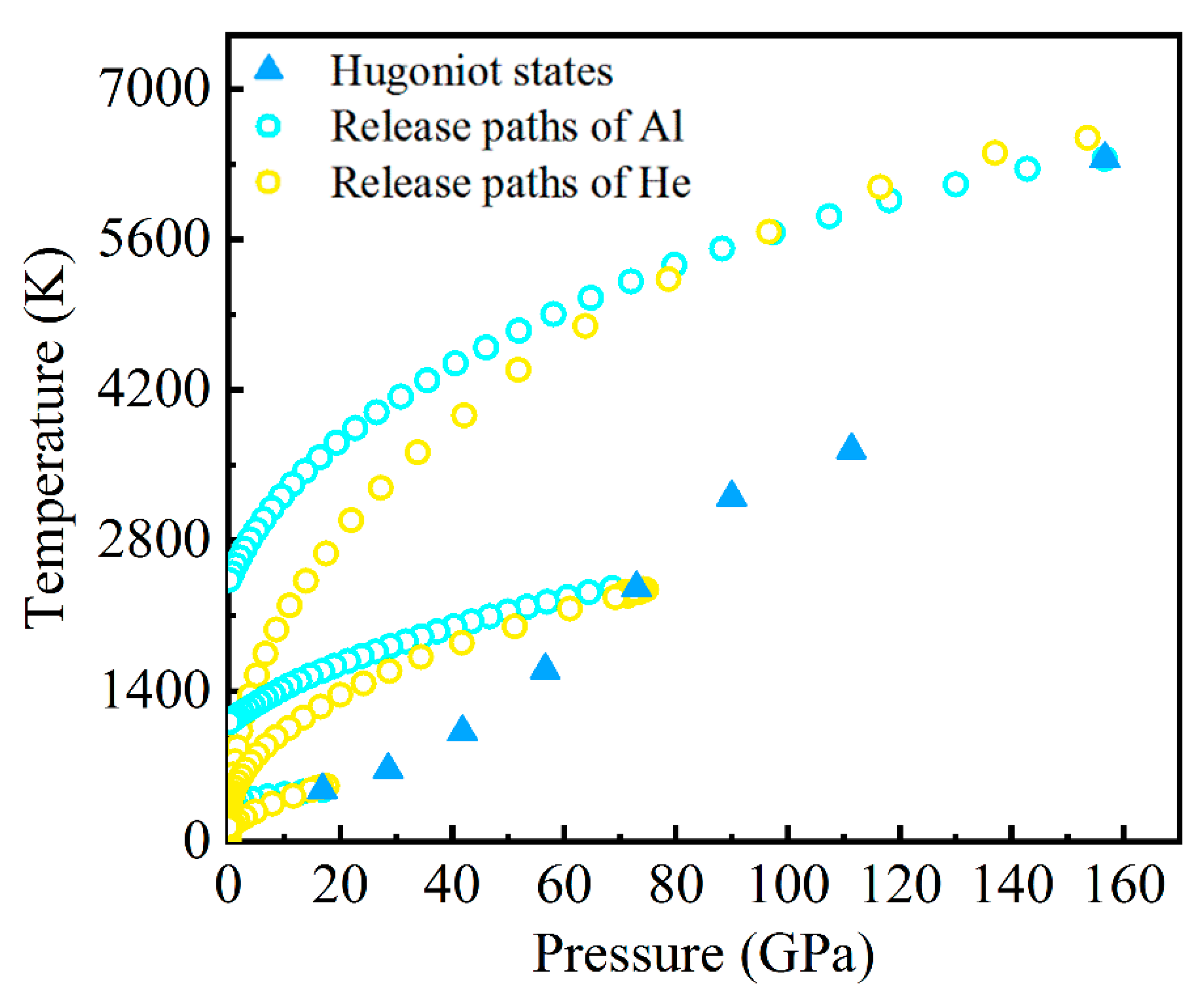
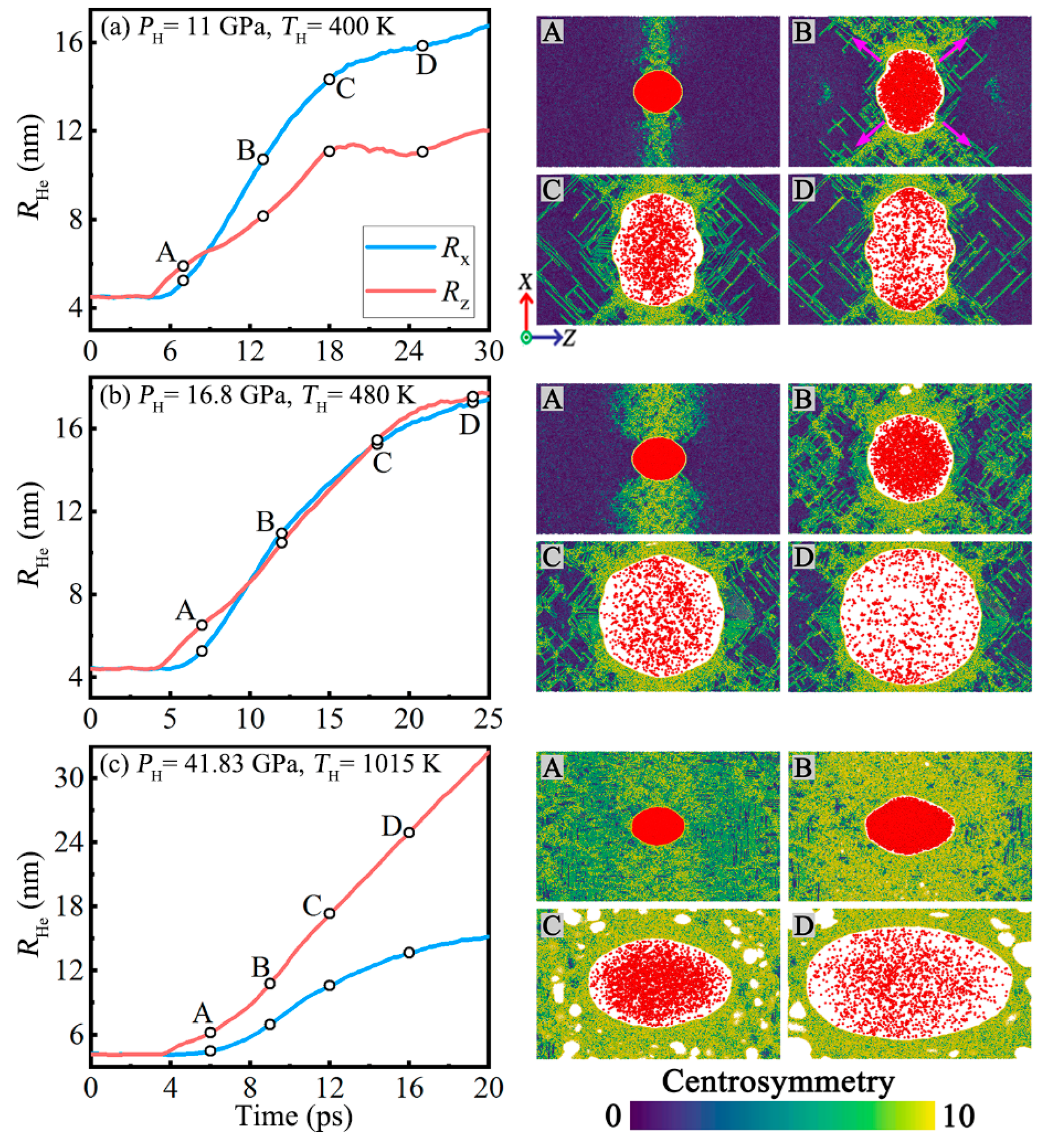
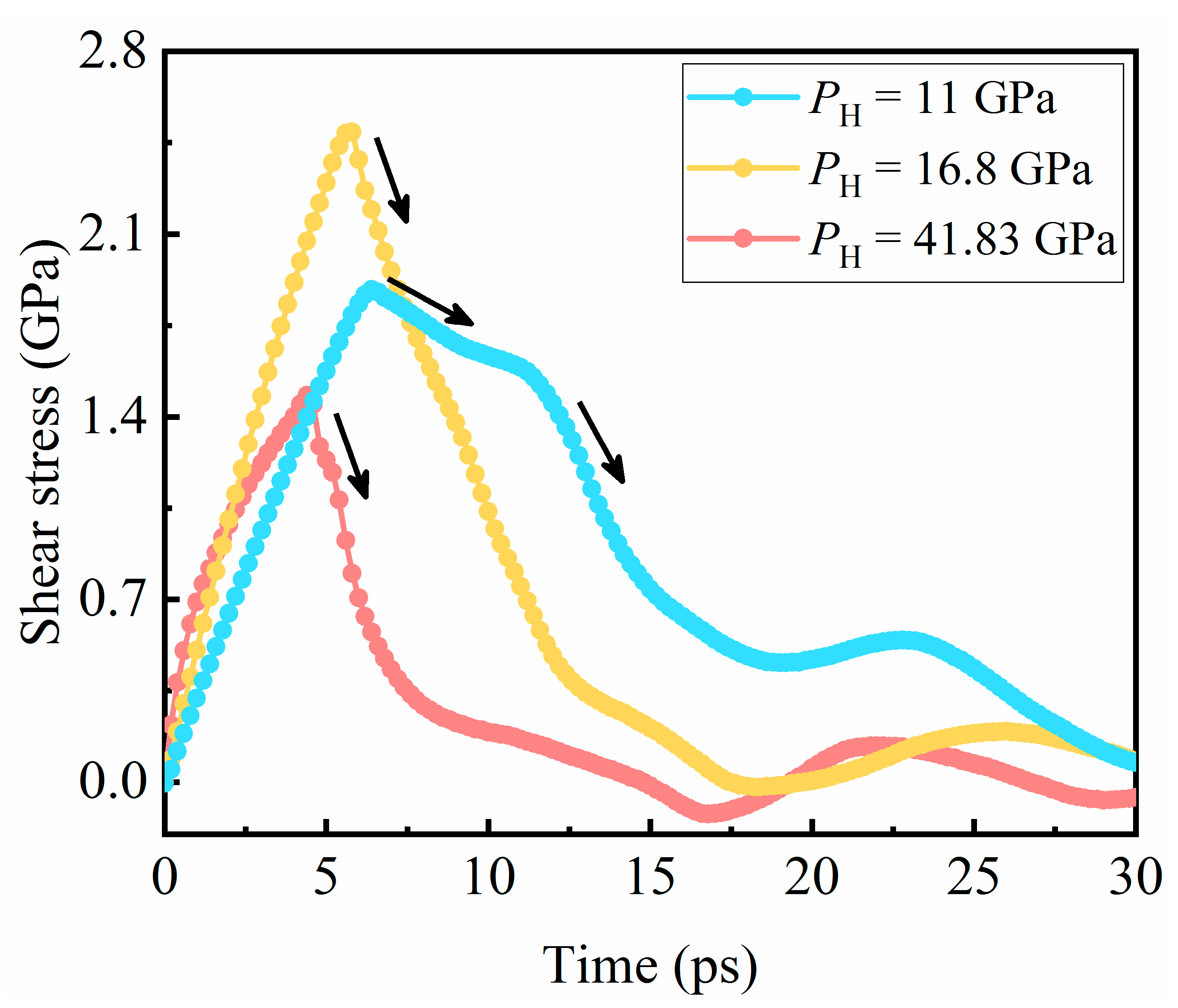
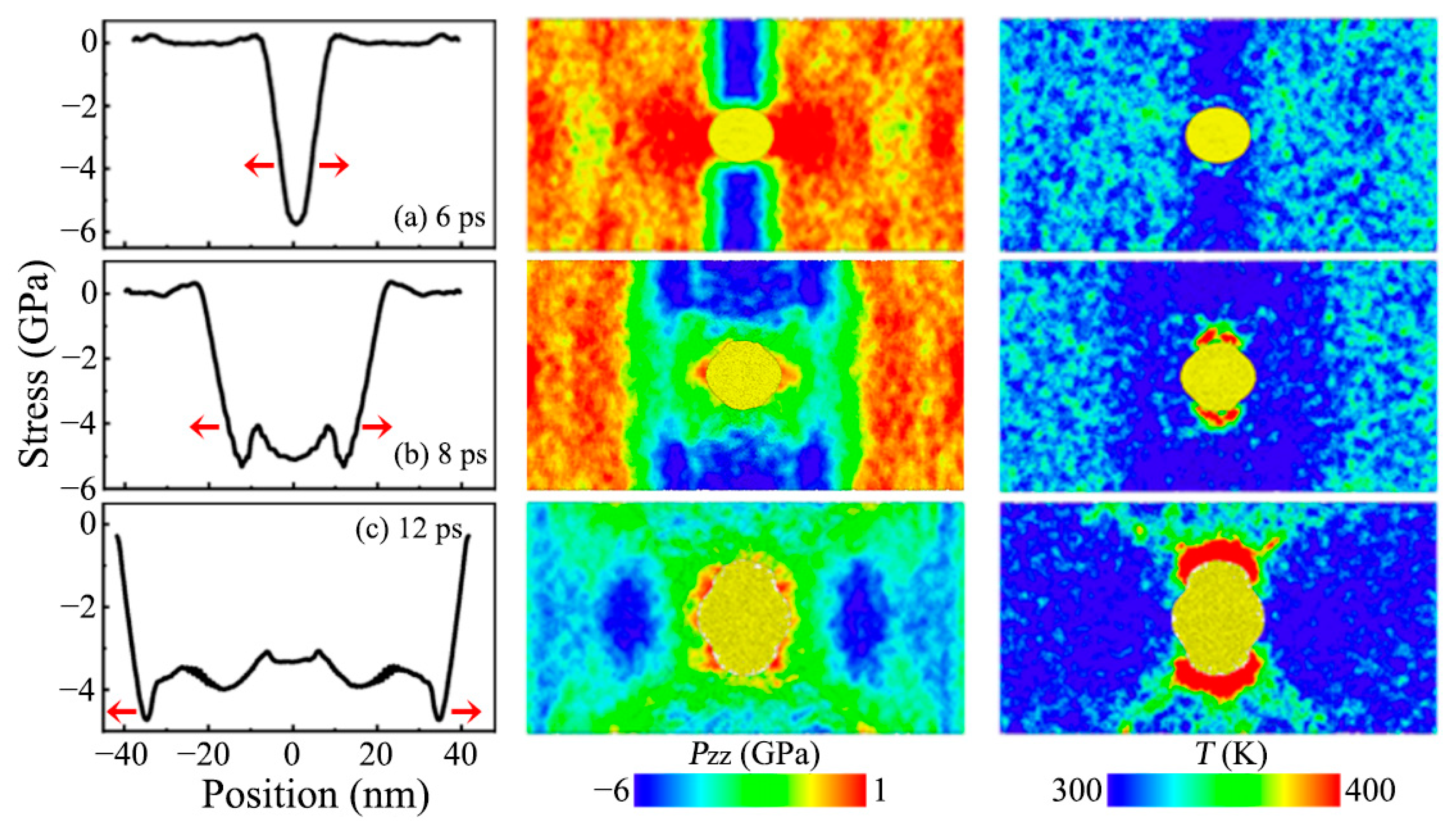

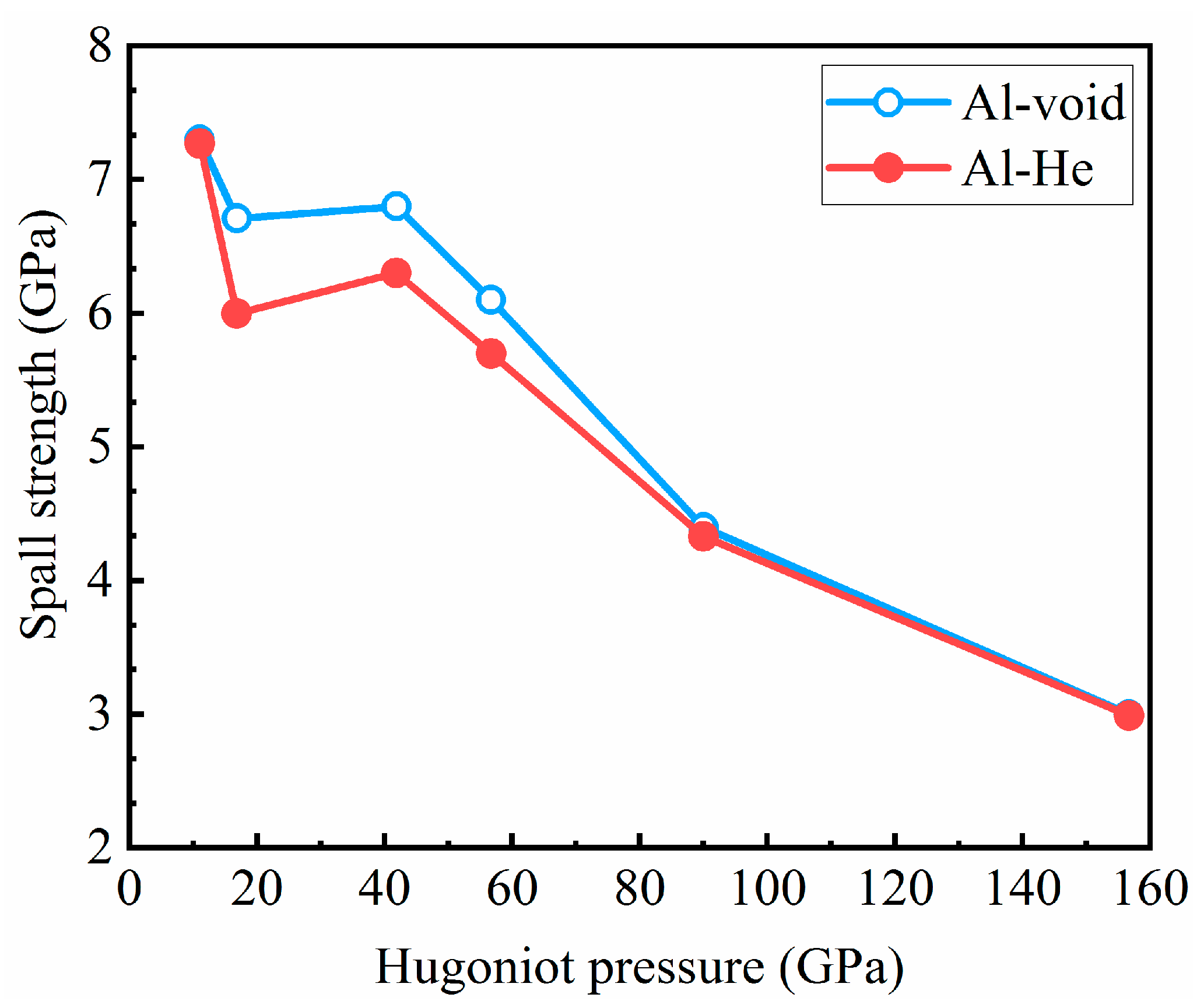
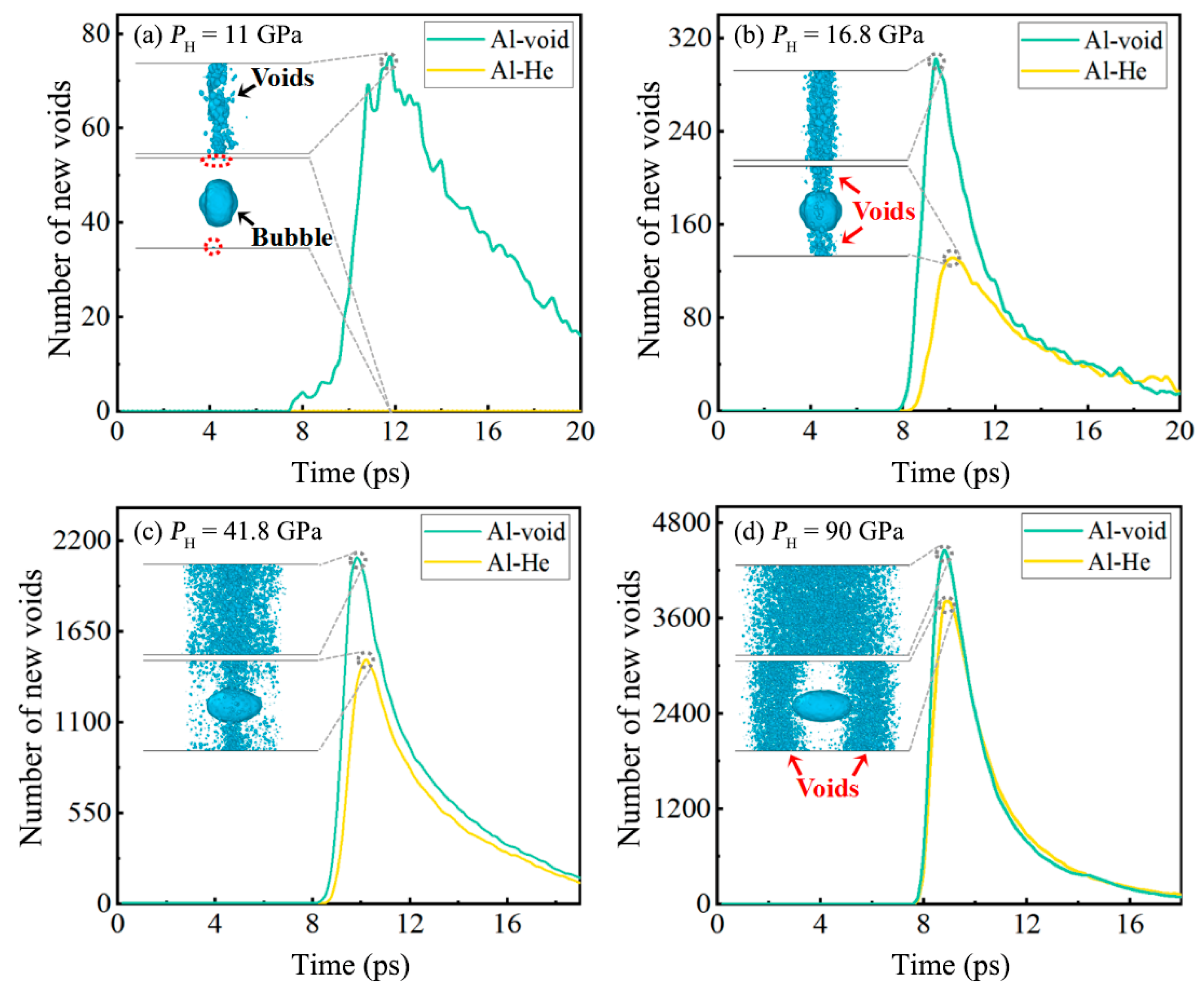
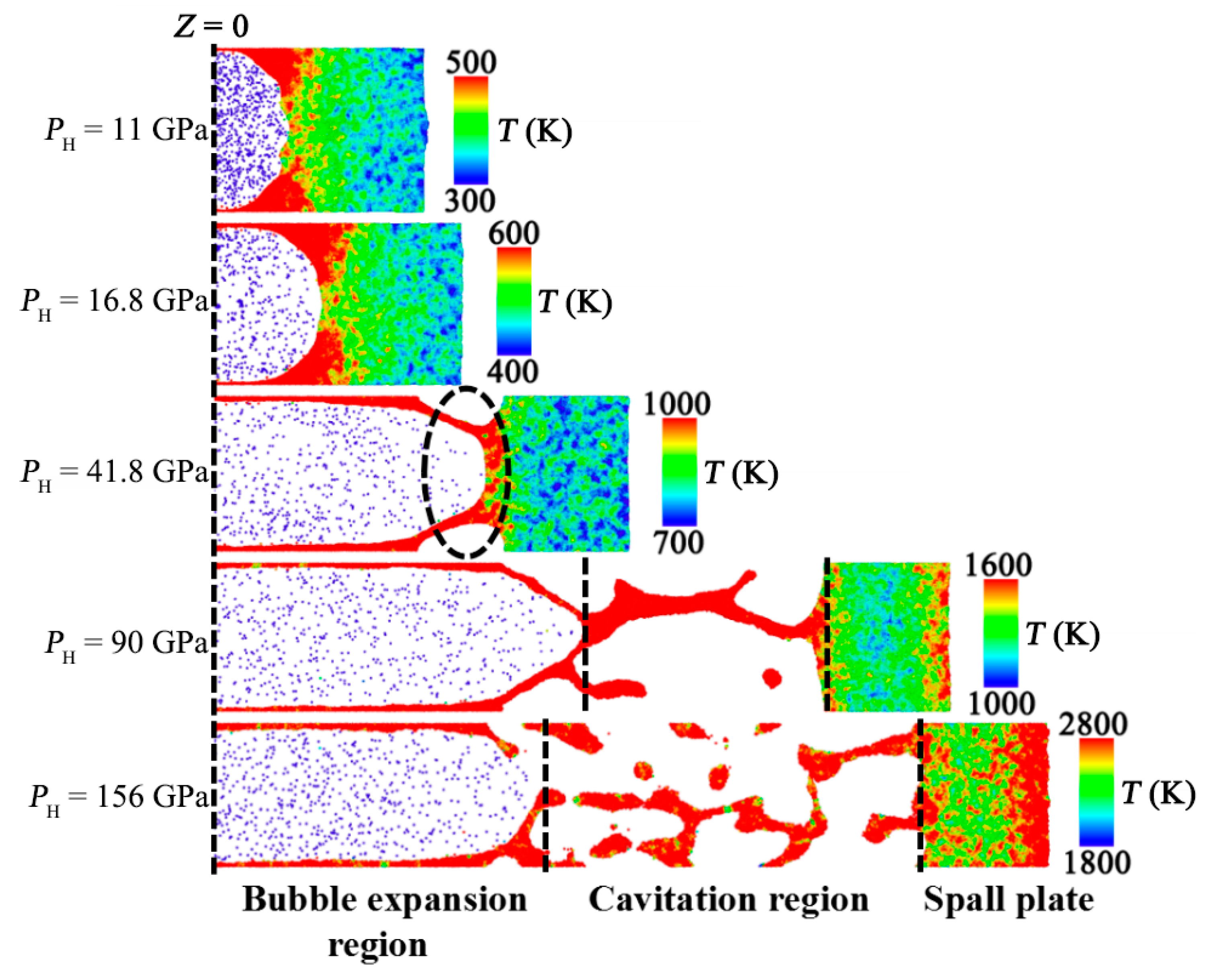
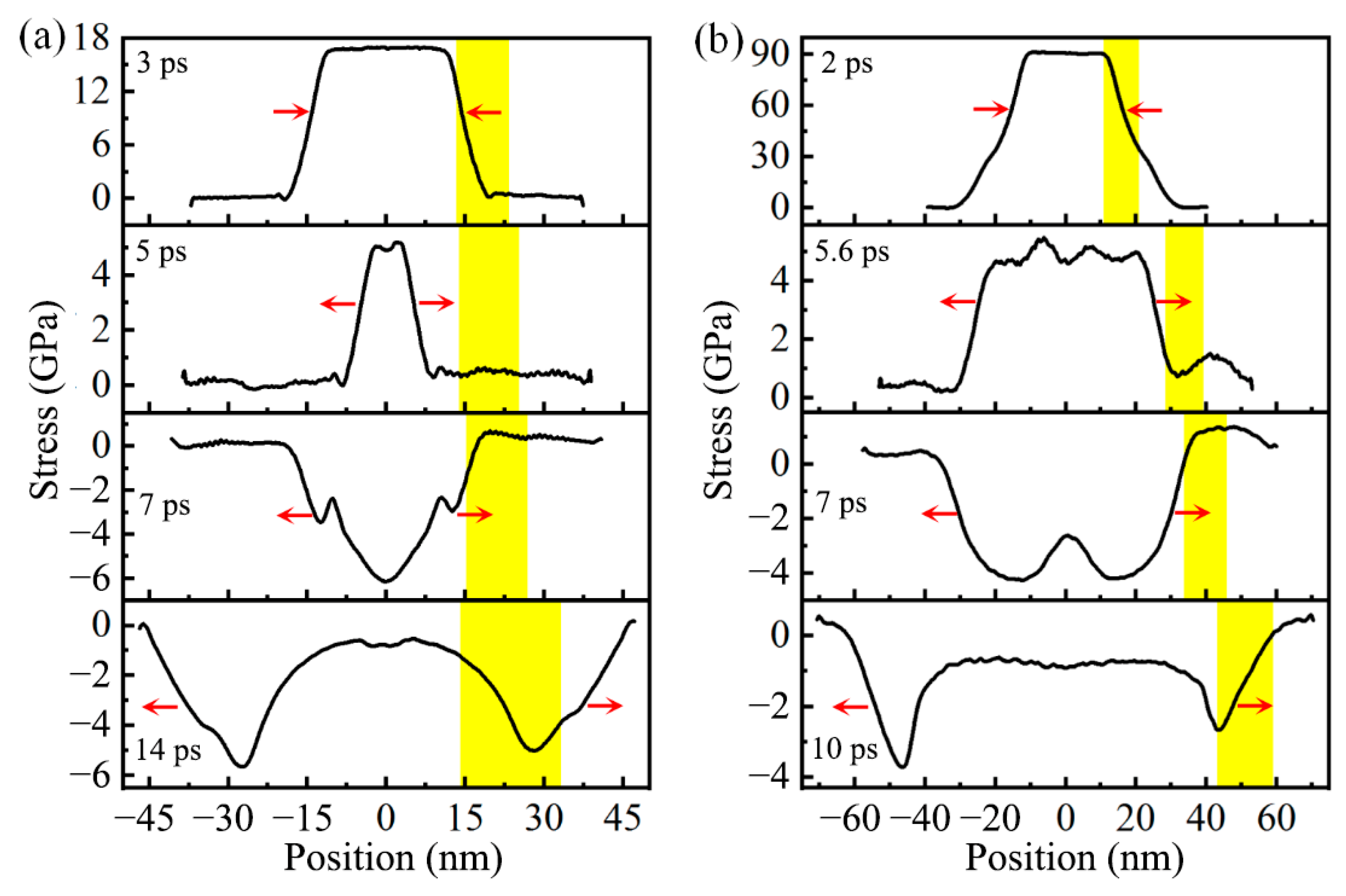
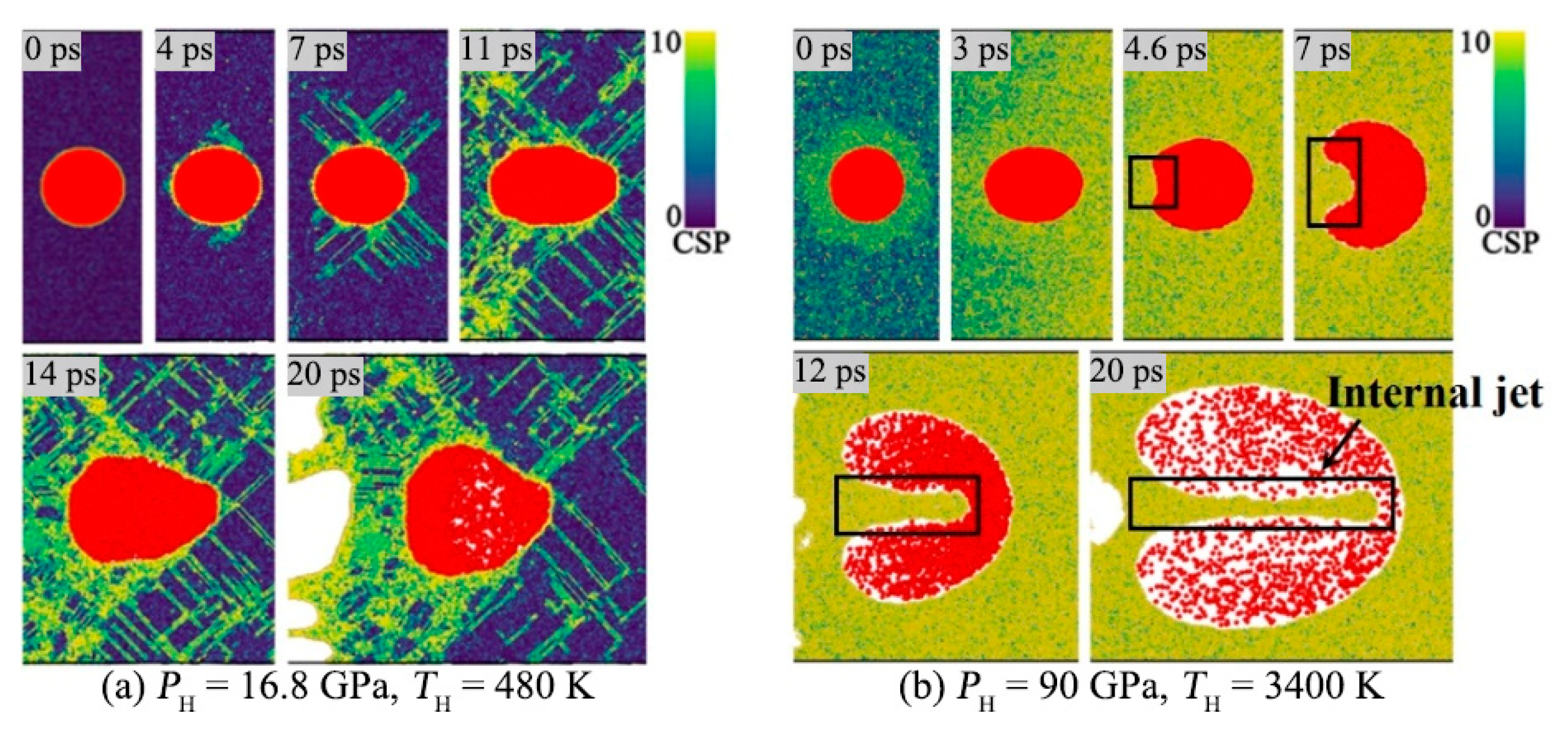
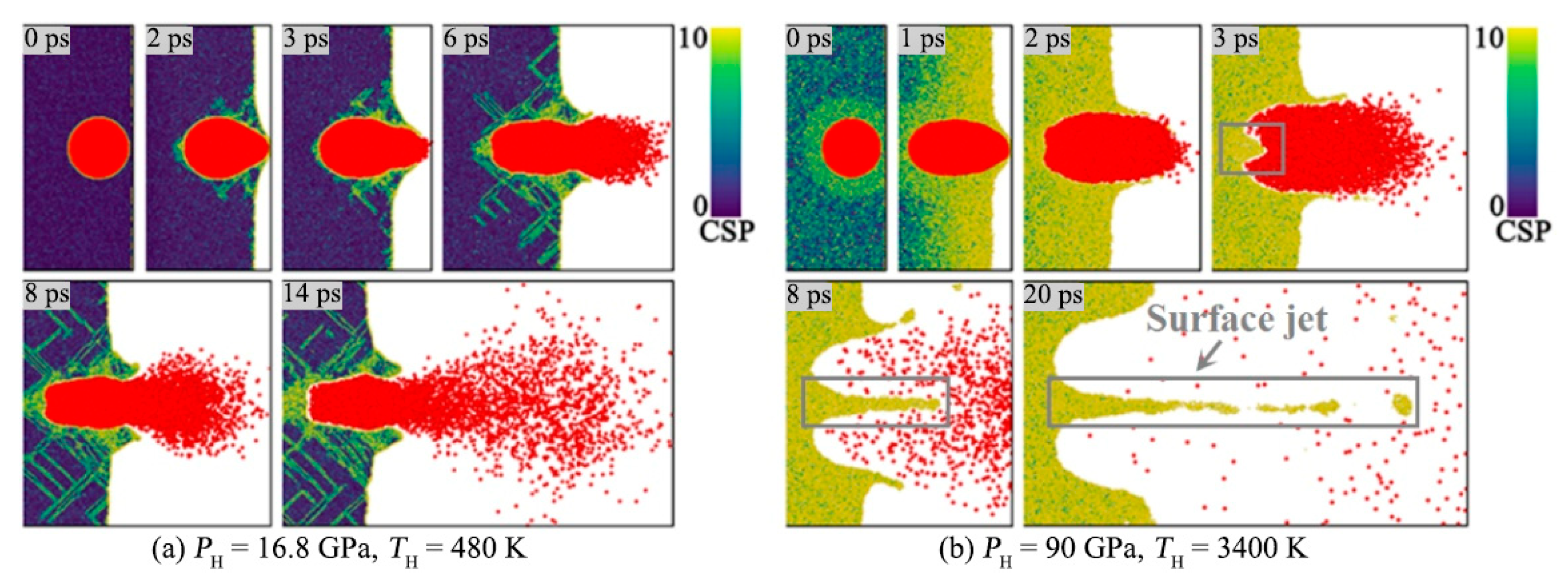
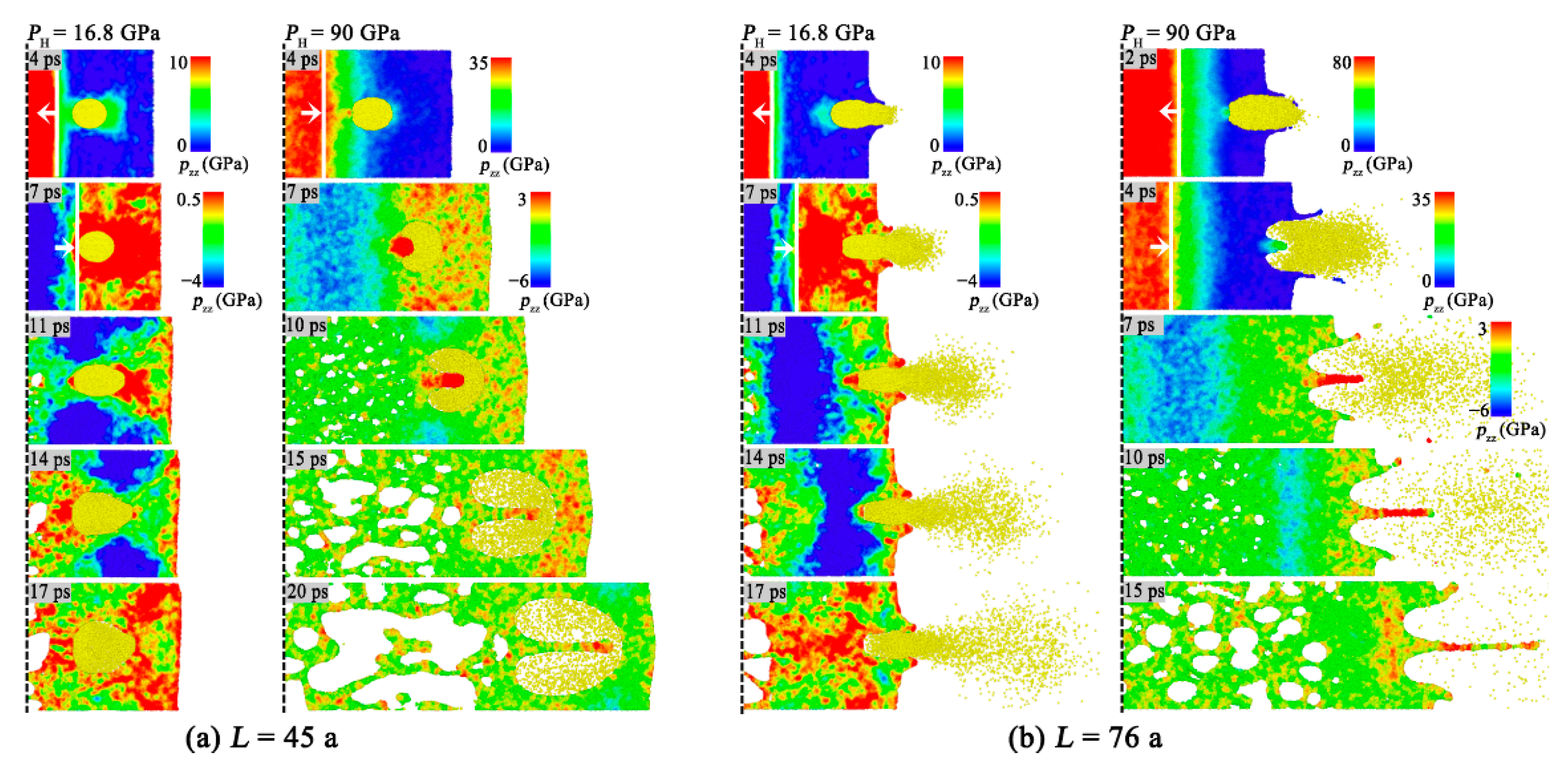
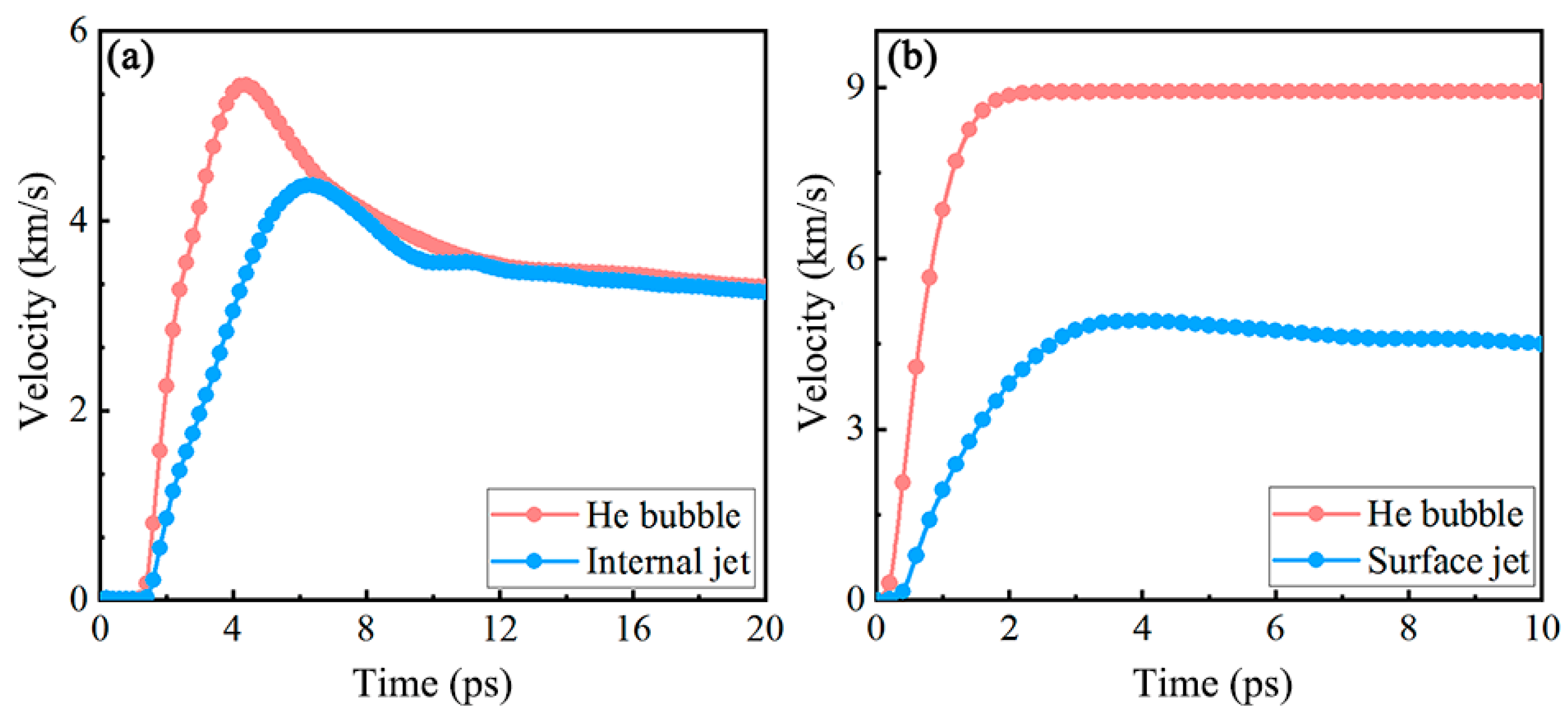
Publisher’s Note: MDPI stays neutral with regard to jurisdictional claims in published maps and institutional affiliations. |
© 2022 by the authors. Licensee MDPI, Basel, Switzerland. This article is an open access article distributed under the terms and conditions of the Creative Commons Attribution (CC BY) license (https://creativecommons.org/licenses/by/4.0/).
Share and Cite
Wu, W.; Shao, J. Dynamic Response of Nanoscale He Bubbles in Single Crystal Al during Release from a High-Pressure State. Metals 2022, 12, 1665. https://doi.org/10.3390/met12101665
Wu W, Shao J. Dynamic Response of Nanoscale He Bubbles in Single Crystal Al during Release from a High-Pressure State. Metals. 2022; 12(10):1665. https://doi.org/10.3390/met12101665
Chicago/Turabian StyleWu, Weidong, and Jianli Shao. 2022. "Dynamic Response of Nanoscale He Bubbles in Single Crystal Al during Release from a High-Pressure State" Metals 12, no. 10: 1665. https://doi.org/10.3390/met12101665
APA StyleWu, W., & Shao, J. (2022). Dynamic Response of Nanoscale He Bubbles in Single Crystal Al during Release from a High-Pressure State. Metals, 12(10), 1665. https://doi.org/10.3390/met12101665







